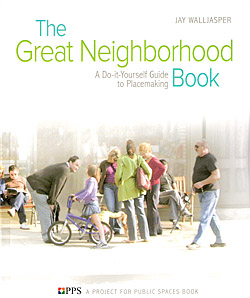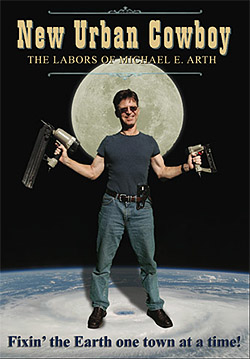
|
||
|
Issue 47 |
|
30 August 2007 |
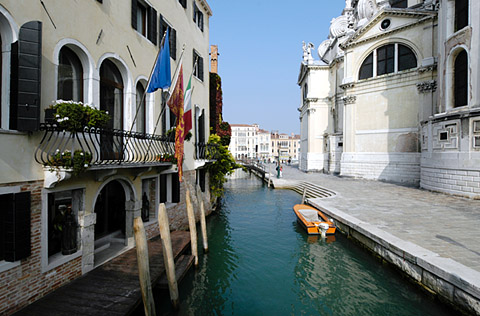 Venice ©2005 J.Crawford Announcements
Carfree Times in GermanThanks to the tireless work of Ulrich Nehls, Carfree Times has been available in German since September 2003. I add a link to the German edition near the top of the English edition when the translation is ready.E-Mail ProblemsMany e-mail addresses are becoming inaccessible to the mail server at Carfree.com. Too many server administrators are blocking too much e-mail. When an e-mail announcement of a new issue bounces, I delete the address without investigating the reason. If you "whitelist" Carfree.com as a sender, mail ought to be delivered. Spam can only be eliminated by charging for e-mail.Bigger, Better (?) Carfree TimesSome recent issues of Carfree Times have included many photographs and the download may be too large for some. Please advise if you have this problem.Carfree Design ManualThe new book is now very close to completion. I hope to have it to the printer this fall.Carfree Cities AvailabilityCarfree Cities is widely available. See the Ordering Information page.Support for Carfree.comTrevor Smith and Shelley Marie Webb paid for September 2007. Ed Beale is keeping us going in October, November & December 2007. Dr. Irving Rudman paid for January 2008. Thanks to all our contributors for their generosity. If you can consider making a contribution, please see the Support Page.
Carfree.com supports World Carfree Network (WCN) by posting the most important network announcements here. Visit the
WCN web site for full information regarding the network's activities.
|
|
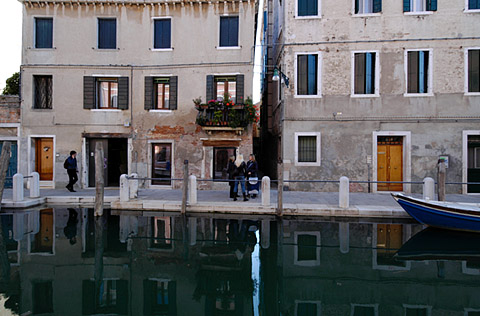 ©2005 J.Crawford The Canals of VeniceIn October of 2005 I spent ten wonderful days in my favorite city. This time I was armed with a digital camera and took 3500 photographs. I have peppered this issue with photographs of Venetian canals, which serve many functions provided by streets in other cities, especially including the delivery of freight.
|
News Bits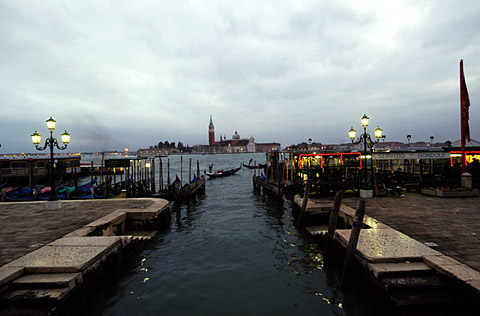 ©2005 J.Crawford Dongtan, a New, Green City?China will build a new city near Shanghai, on an island in the Yangtze River. The marshy island, about the size of Manhattan, is a migratory stop for an endangered bird species. The new city will be called Dongtan, and construction will start late this year. The city will be connected to Shanghai's new airport and the financial district by metro. The ultimate population target is 500,000.This will be a green city in a nation not known for environmental sensitivity. (In some provinces, over 90% of the trees have been cut.) Toxic waste dumps abound and rivers run black. Environmental damage increased in the 1980s, when China's explosive economic growth began. Overseas companies located their most toxic manufacturing operations in China. Energy demand soared, and China now opens a new coal-fired power plant once a week. China will soon surpass the USA as the largest emitter of greenhouse gases. Since 2001, Chinese emissions have increased by more than all the other industrialized nations in the world combined. China got richer, although about 10% of Chinese people still live on less than a dollar a day. And pollution is now costing China an estimated 10% of its GDP. The cost to public heath and quality of life is huge. Government figures show that 300,000 people die prematurely each year just from air pollution. China must overcome its history. One of the most instructive lessons from the planning of Dongtan was an understanding that low-density, US-style development didn't stand a chance of reaching the sustainability targets. The designers looked at energy consumption in cities and plotted energy against density. They concluded that very high density, as in Hong Kong, only slightly improved the picture when compared to the moderate density of a city like Stockholm, so they settled on about 50 people per acre (around 125 per hectare) in mid-rise buildings. But a funny thing happened. When they started plopping sample blocks onto the site map, they discovered that they could put ten times as many people as anticipated onto a smaller proportion of the site than proposed in alternative designs. In fact, they would build on only 35% of the site, in locations clustered along the public transport lines. Mixed-use neighborhoods will be the norm. The Dongtan master plan is a green response to China's environmental crisis. The city is to be powered by local, renewable energy sources. Efficient buildings are to be clustered in dense, walkable neighborhoods. Most wastes are to be recycled. Vehicles that emit CO2 are banned. Today the site is completely undeveloped, but that will begin to change at lightening speed in a few months. Will Dongtan become a model for the rest of the world? It's not possible to say yet, but it is an ambitious and promising undertaking. At the Shanghai Residential 2000 conference (held in 1996), I proposed a city very much like the Reference Design. The proposal was for a city of a million, on a site not far from Dongtan. At the end of my presentation, the Iranian-born architect Hossein Amanat stood up and pleaded with the Chinese not to repeat the American auto-centric mistake. Maybe people were listening.
"Pop-Up Cities: China Builds a Bright Green Metropolis" 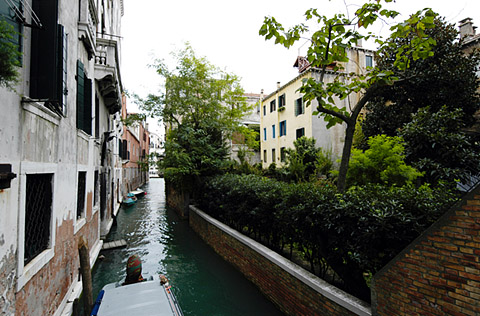 ©2005 J.Crawford Dream On, PleaseArtist Emil Choski is sick and tired of traffic and fumes on Bedford Avenue in the Williamsburg section of Brooklyn. His dream is simple: "Car-Free Bedford." Ban all traffic on a 10-block stretch of the major artery. Make it into a promenade with restaurants and cafés. Plant grass and trees down the middle of the road. Replace gutters with bike lanes and concrete with cobblestones.The daring artist imagines that the community will become livelier. He says that trees and flowers don't kill people, traffic does. Foot traffic is already so heavy during the summer that pedestrians take over part of the street. Choski is gathering support from local business and community leaders, with more success than might be expected. He is, alas, battling history. Hundreds of pedestrian malls were opened in North America during the 1960s and 1970s, but only about 30 remain vital. (Most of the failures were outdoor bus stations dubbed "pedestrian malls.") He cites Stone Street in Lower Manhattan as a model for what Bedford could be. This narrow cobblestoned street was built in the 17th century by Dutch colonists. It was closed to traffic in the mid-1990s, when it became a popular dining and shopping area.
"Car-Free Bedford: 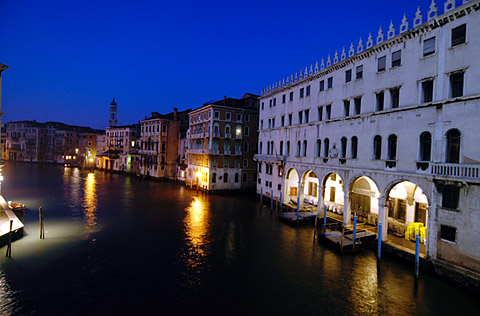 ©2005 J.Crawford Transit-Oriented Development. . . In Los Angeles Suburbs?Transit-Oriented Development (TOD) is coming even to metropolitan Los Angeles. The suburban Tarzana Neighborhood Council has proposed TOD in an area around an Orange Line metro station. Tarzana Crossing would be arranged as a transit village or an urban village (my own preferred term) - with shops, restaurants, offices, and housing all within a quarter-mile of the station. It would be a pedestrian environment, with buildings rising up to six stories at the core, with ground-floor shops.TOD is proposed as a response to the realization that greater population density will come to Tarzana and other places along the Orange Line, whether people want it or not. (It's crazy to build heavy transit infrastructure and then not put destinations next to the stations; San Francisco's BART often puts the lowest and least valuable use, parking, next to the stations.) City planners are impressed by the Council's plan and by the willingness of residents to consider increased density and mixed uses. There is, in fact, a desire by Mayor Antonio Villaraigosa and city officials to develop urban villages along the city's transit lines. City administrators understand that patterns of development must change to accommodate rising populations and land shortages. Urban Planning and Design Coordinator Krista Kline said: We have to build higher. In order to do that and still make the community livable, you have to make communities better than they are now.Scott Albright, a Santa Monica city planner who sits on the Council, said: People have an inherent desire to identify with a place.Maybe this time the dawn is breaking in the west, in the heart of America's long experiment with auto-centric cities.
"Tarzana council proposing Orange Line village" [PDF!] 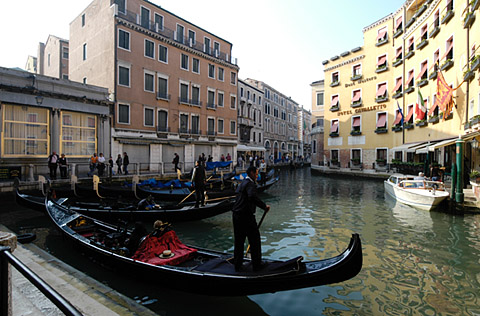 ©2005 J.Crawford Cheap Cars for IndiaTraffic on India's already choked roads is poised to become even worse. Manufacturers are scrambling to introduce cheap Indian-made cars, some under US$2500. (Similar prices are emerging in China, which suffers from the same general circumstances.) India today has just 7 cars per 1000 people. If this rises to the level of car ownership in the rich world, India will soon have 70 times more cars on the road. India may become the principal testing ground for cheap cars. Just as rising wages and the cheap, small, reliable Honda motorcycles transformed the region a few decades ago, rising wages and cheap cars may transform it again. The first transformation was not wholly negative, despite serious air pollution problems. Most streets were wide enough to accommodate heavy motorcycle traffic, and nearly a billion people in Asia gained better mobility. This time, there won't be anywhere near enough room on the streets and highways. India holds the dubious distinction of the highest number of road fatalities in the world. Last year the road death toll stood at more than 60,000. In part it is the mixture of fast-moving motor vehicles with slow-moving ox carts, bicyclists, and pedestrians on the highways. Major roads pass through the centers of towns and villages. Even limited-access highways have become killing grounds as pedestrians are struck trying to cross them. The tragedy is that railroads served India admirably for more than a century, but they are so overcrowded today due to flagging investments that a ready market for cars is emerging. This will not only worsen the hazards from collisions but also increase deaths from air pollution. This trend must be reversed.
"India races for the world's cheapest car" 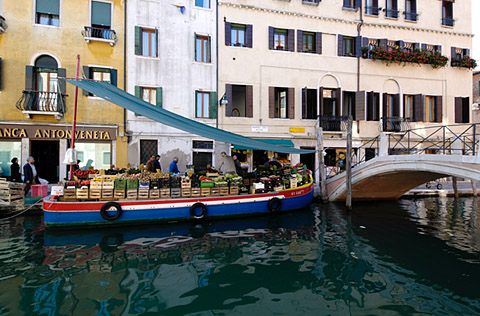 ©2005 J.Crawford Bikes to the RescueThe WHO called for urgent measure to reduce CO2 emissions in Asia before they threaten health and even the economy. Climate change is already blamed, directly or indirectly, for 77,000 deaths a year in Asia, mainly due to increases in malaria and other mosquito-borne diseases. The dramatic expansion of Asian economies is expected to cause sharp increases in emissions.A UN report warned earlier this year that billions face water shortages and starvation if damage to Earthís climate alters rainfall patterns, strengthens storms, and raises the risk from drought, flooding, and water stress. Greater use of bicycles, clean energy sources, and tax incentives to reduce carbon emissions are cited as essential steps. And fewer, not more, cars.
"UN Calls for Pedal Power to Reduce Environmental Damage" 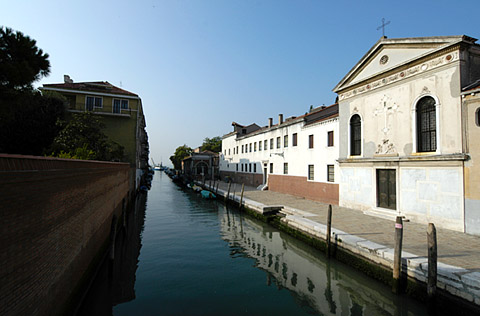 ©2005 J.Crawford Fat KidsA confidential 74-page draft document prepared for the UK Department of Trade and Industry says:A target on childhood obesity was introduced to halt the year-on-year rise in obesity among children aged under 11 by 2010 in the context of a broader strategy to tackle obesity in the population as a whole. As yet there is almost no evidence that the [rate of] rise in obesity levels is changing.
"Half of all boys will be obese, warns leaked report" 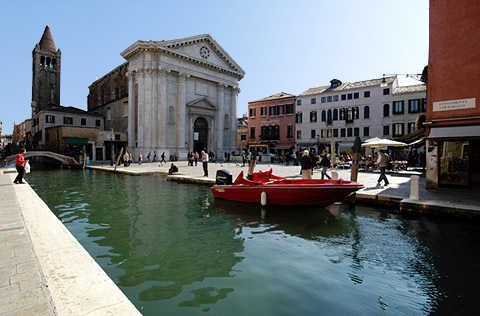 ©2005 J.Crawford Go Outside and PlayMaybe a little wisdom is finally dawning in modern life. Freelance writer Dianne Rinehart recently wrote in the Montreal Gazette:"Go outside and play."She complains that "entire industries are springing up to resolve health and behavioural problems caused by not letting kids participate in unsupervised, unstructured, outdoor play." Kids are getting fat because they can't play outdoors. The Fisher-Price solution is a stationary bike with video games. The latest rage on TV is exercise shows for kids. She says, "If all this sounds more like work than play, you can understand why kids are going rangy." The pharmaceutical industry stands ready. More kids are being given Ritalin for ADHD, anti-psychotics, and anti-depressants. What about just sending them outdoors to run around? She says, "Taking a walk can be as effective at combating depression as taking a pill, so imagine what playing tag would do for them (or you)." Schools have removed playground equipment out of fear of lawsuits. "Now, they need fitness club memberships; 'play' is a 'work' out, and it has to be scheduled into mum or dad's day, so they can drive them there." It gets even worse. Kids aren't learning the creative thinking that play develops. Play helps kids to become confident, independent, problem-solving adults. If it's all wrapped up in cotton batting, it doesn't work. "Kids need to fall from trees and, yes, live a little dangerously . . . to be prepared to meet life's challenges." I spent a good deal of my childhood building tree houses, which taught me things I would not otherwise have learned. Ms. Rinehart waxes poetic: My late mum, who might have been a bit laissez-faire even for our day, sent her kids out to play without any rules that I remember. Her "negligence" allowed us full rein not only of the terrain, but our imaginations. I ran through meadows, climbed up and down the escarpment, and played explorer with my girlfriend, whose father dropped us in unknown wilds, leaving us to leap streams, build forts, catch frogs and explore spooky paths. Apparently even the Royal Society for the Prevention of Accidents sees the risks of an overprotected childhood and is now urging parents to tolerate more risk to help kids learn "valuable life-long lessons, particularly about risks and how to deal with them, from playing in the natural environment." Ironically, our urge to protect children is killing them. Fearing abduction, we keep them inside and drive them everywhere. The result? Thirty per cent are now overweight, with resultant health risks, and more are dying in car accidents (the odds increase with more time spent in them) and being hit by vehicles - most often outside schools by parents dropping off their own kids. Meanwhile, a lack of exposure to sunshine is blamed not only for vitamin D deficiencies, but this week a study linked it with the rise in the number of cases of autism.This is serious stuff. It's time we played attention.
"Canadian kids are out of play: 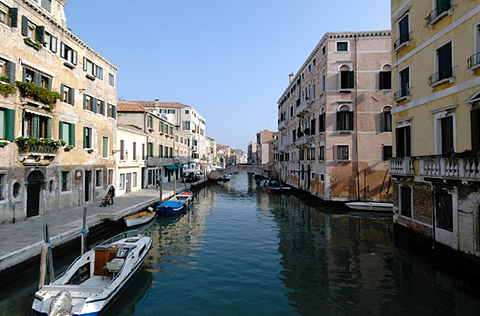 ©2005 J.Crawford Slim Kids, Walking to SchoolA UK think tank has called for car exclusion zones around schools, to force children to walk. Parents should not be allowed to drive within a half-mile radius of a school. Carfree areas should be established around shopping centers, to prevent unnecessary short journeys.The report, "Unfit for Purpose: How Car Use Fuels Climate Change and Obesity," from the Institute for European Environmental Policy says that increased car use fosters the "twin crises" of obesity and global warming. The report claims that walking for just one extra hour a week could stave off a weight gain of 28 pounds over ten years.
"Car-free zones around schools 'can beat obesity'" 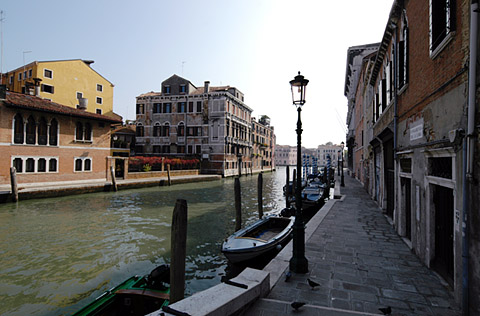 ©2005 J.Crawford Cars are Even More Toxic Than We ThoughtEngine exhaust is even worse for health than had been thought. Those living within a radius of 200 meters (about 650 feet) of a busy road have a much higher chance of hardening of the arteries. Within 50 meters (about 165 feet), the chance is 63% higher than normal, according to an article by German scientists in Circulation."It does not have only to do with freeways but also to do with busy streets inside the city," according to Vlemming Cassee, a project leader at the Dutch Institute for Health and Environment (RIVM). " In Amsterdam, those who live near the A10 [a ring road] run an increased risk, and also those living on the Stadhouderskade or the Overtoom [busy streets near the city center]." The health effects are probably a result of a combination of fine particulates, SO2, CO, and the stress effects of noise, which also contributes to hardening of the arteries. The researchers did not identify a specific toxic component but determined that the effect is related to proximity to heavy traffic.
"Sneller ziek in huis bij snelweg" 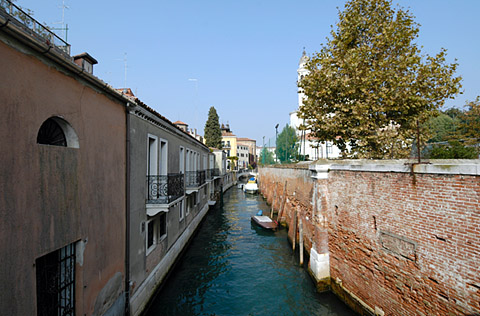 ©2005 J.Crawford Bad News About NoiseLong-term exposure to noise is killing large numbers of people prematurely, due to heart disease caused by noise. Coronary disease killed 101,000 in the UK during 2006. A study suggests that 3,030 of these were caused by chronic noise exposure, including traffic.In addition to the heart disease link, the Noise Environmental Burden on Disease work group found that 2% of Europeans suffer severely disturbed sleep because of noise and 15% suffer severe annoyance. Chronic exposure to noise also causes tinnitus, a continuous ringing sound in the ears. Recent research shows that noise raises levels of stress hormones, even during sleep. The longer these hormones circulate, the greater the chance that they will cause life-threatening physiological problems, such as heart failure, strokes, high blood pressure, and immune system problems. Even people who think they are not bothered by noise suffer from its effects. Researchers compared households in noisy areas with those in quieter locations. WHO guidelines hold that the noise threshold for cardiovascular damage is a night-time exposure of 50 dB, about the level of light traffic. For sleep disturbance, the threshold is only 42dB, for general annoyance just 35dB.
"Noise of modern life blamed for thousands of heart deaths" 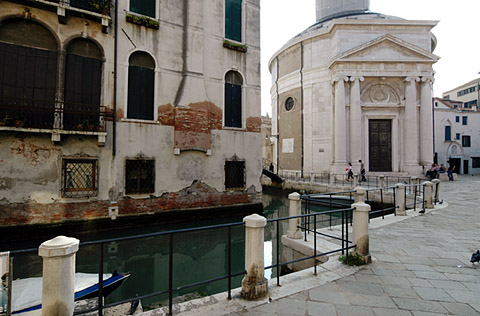 ©2005 J.Crawford Please Don't Buy That CarXu Zongheng, the mayor of Shenzhen, has pleaded with citizens not to buy any more cars because of monumental air quality and traffic problems in this, one of China's largest and fastest-growing cities. He said that car ownership is growing far faster than the city can build new roads. The mayor said, "Although I have no legal power to do this, I am asking everyone to not buy cars." He said that the city's car fleet is expected to increase by 200,000 this year, and that car emissions are responsible for some 70% of air pollution.
"Shenzhen citizens urged to stop buying cars" 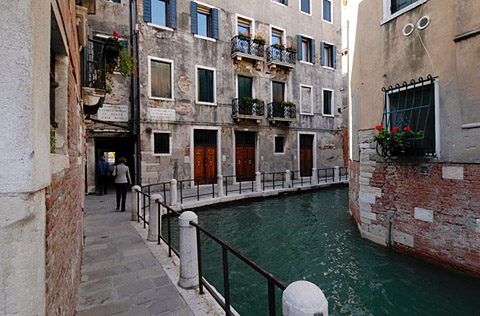 ©2005 J.Crawford A Few Necessary Deaths"Death and injury on the roads is the world's most neglected public health issue," claims a recent article in The Guardian. 1.2 million people a year die in road collisions, almost as many as from malaria. Some 50 million are injured. The collisions are disproportionately in poorer countries, and it is poor people who are hurt as they walk, bike, or ride on rickety buses. Children walking along the roads have the highest death rate. Yet what is being done about this carnage?The economic cost to developing economies, in lost productivity alone, is about equal to the amount they receive in foreign aid. About half of the hospital beds are occupied by people struck in road accidents. The human cost is unthinkable. The problem will only get worse. The World Bank estimates that by 2020, deaths from road collisions will rise by 83% in poor nations (while falling somewhat in rich ones). The foreign aid budget for preventing and treating malaria is about 200 times larger than for road safety. The Guardian says: This issue has been neglected partly because it is something the rich inflict on the poor, and partly because it is widely perceived as an unavoidable price of doing business - as the global transportation industry expands, so must its human costs. Governments are just beginning to wake up to the problem. But the corporations got there first.At the behest of the World Bank in 1999, the road industry established the Global Road Safety Partnership. It was to bring all players together to fight the problem. But its executive committee is composed almost entirely of industry representatives. The organization has neglected the plight of pedestrians and cyclists. Talk of speed limits is all but banished. Professor Ian Roberts at the London School of Hygiene and Tropical Medicine noted that "Reclaiming the streets for walking and cycling will not serve the interests of the car makers." The "Partnership" emphasizes driver training and safety education for children. ("Don't play in the streets.") The transport is protected. But, according to Roberts, these measures don't work. The Guardian asks: Is this the vision: that the space now used by pedestrians and cyclists and ox carts and rickshaws is surrendered to car drivers? If so, it might reduce fatalities, but it would also represent a classic act of enclosure, through which the rich are able to secure the resources of the poor.
"A Million Road Deaths Every Year? 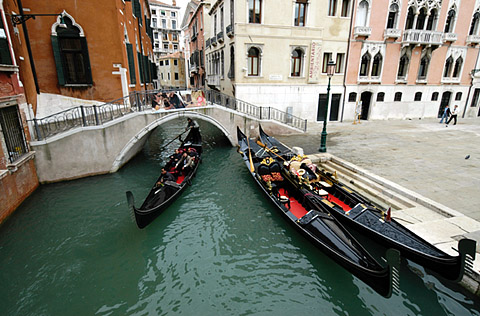 ©2005 J.Crawford King Coal Rears Its Filthy Head AgainThe coal lobby is hard at work in Washington. In a move so absurd that it would be funny if it weren't true, coal is being dressed up as "the king of alternative fuels." Legislators from coal-rich states are proposing government-guaranteed loans for coal-to-liquid plants. Guaranteed minimum prices for the new fuel are proposed, along with guaranteed government purchases for 25 years. It's a sweet deal.Big coal claims that coal-based fuels are somehow more American than gasoline and greener than ethanol. Rep. Nick V. Rahall, chair of the House Natural Resources Committee, said "For so many, filthy coal is a dirty four-letter word. These individuals, I tell you, have their heads buried in the sand." The size of the proposed subsidies for coal far exceeds those for any alternative fuel, including ethanol from corn (itself a boondoggle). Proposed are loan guarantees for 6-10 major coal-to-liquid plants (each costing $3 billion), a tax credit of 51 cents a gallon through 2020, automatic subsidies if oil drops below $40 a barrel, and a 25-year Air Force contract for a billion gallons of jet fuel a year. If you own a coal mine, you can't lose. New plants costing $70 billion would supply just 10% of US gasoline. As usual, lobbyists are spraying money around. They have enlisted organized labor, the Air Force, and the airline industry. Peabody Energy, the world's biggest coal company, ran an ad campaign urging people to "imagine a world where our country runs on energy from Middle America instead of the Middle East." Presidential candidate Barack Obama is leading the way. Bush called for "alternative" fuels, not "renewable" fuels. The distinction was lost on many, but the language was deliberately arranged to make room for coal. The industry thinks that fuel from coal can compete against gasoline if oil prices are above $50 a barrel (and as long as they get those juicy subsidies). Coal is, of course, the worst fuel there is by any measure except abundance. It produces the most CO2 per unit energy, its extraction causes exceptional environmental damage, and it is laden with toxic contaminants. Conversion technology has been known for years, and the product is compatible with existing fuel streams. However, the conversion is itself inefficient, causing even more greenhouse gas emissions than simply burning the coal in a power plant. It is claimed that the CO2 from the conversion process would be stored underground or injected into aging oil wells to sustain production. The economic viability of the processes is apparently not yet demonstrated, which probably gives rise to the demand for subsidies. If it works, the coal companies make billions. If it doesn't, the government loses billions, the industry little or nothing. The carbon-sequestration aspect of the plan is still hypothetical. Large amounts of energy would be consumed to separate the CO2 from stack gasses and compress or liquify it. Howard Herzog, a principal research engineer at MIT, said, "At best, youíre going to tread water on the carbon issue, and youíre probably going to do worse. It goes against the whole grain of reducing carbon."
"Lawmakers Push for Big Subsidies for Coal Process" |
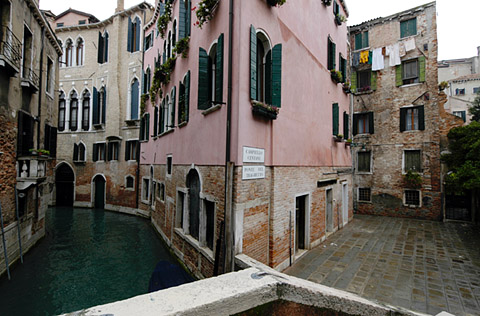 ©2005 J.Crawford Protecting GreenbeltsBritish Chancellor of the Exchequer, Alistair Darling, and Communities Secretary, Hazel Blears, advocate building in Britain's green belt to solve the housing crisis. As the Observer said, "Such a retrograde step would constitute a foolish betrayal of Britain's landscape as well as Labour's values."J.B. Priestley complained, during a 1933 trip through what had once been rural England: This is the England of arterial and bypass roads, of filling stations and factories that look like exhibition buildings, of giant cinemas and dance halls and cafes, bungalows with tiny garages, cocktail bars, Woolworths, motor-coaches ... and everything given away for cigarette coupons.Pre-war Britain attempted to stop the Californication of Britain by establishing green belts, most of which have been preserved more or less intact until today. A movement arose for the use of rural areas by ordinary people. Cycling and scouting took to the countryside. The Observer says: In 1935, the Greater London Regional Planning Committee proposed 'to provide a reserve supply of public open spaces and of recreational areas and to establish a green belt or girdle of open space'. The Town and Country Planning Act of 1947 took the principle further with a London green belt and a generation of new towns to house the populations of bombed-out cities.The huge irony here is that Britain has already demonstrated the power of urban redevelopment with many hugely successful projects to reclaim its urban heartland. There's no need to invade the greenbelts, only to redevelop the brownbelts. The Observer issues a call: Similarly, the scheme for eco-towns is an interesting update of Labour's new town ethic. These developments should be opened up to a well publicised national competition: an unashamedly modern alternative to Prince Charles's Poundbury and a chance for architects Terry Farrell or Piers Gough to show Britain has not lost its tradition of townscaping.I remember the Britain of 1965. I was awed by London, a magical, livable city, that contrasted with incomparable rural areas. It would be tragic if this heritage were to be abandoned to the greed of a few developers.
"The green belt is no place for homes: |
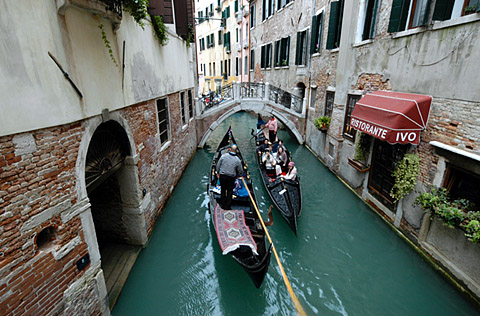 ©2005 J.Crawford Feature ArticleHumanizing EnergyJ.H. CrawfordA recent discussion on the Carfree_Cities list made me realize that people have no real conception of just how much energy they are using. One member thought that he could obtain important amounts of energy from the rainwater falling off his roof. His discussion showed an ignorance of the difference between energy and power, which a basic knowledge of physics provides. This person is, of course, not alone in his failure to understand that rainwater falling a few meters off a roof produces a negligible amount of energy, at least in the context of how much energy we are using. So, let us make some comparisons of the energy we consume with the energy we can produce ourselves.How much power can you generate by pedaling a stationary bicycle connected to a generator? A normal adult in decent condition can produce 0.1 HP continuously for eight hours a day. One horsepower is 746 watts, so our average adult can generate 75 watts. That works out to: 75 watts * 8 hrs = 600 watt-hours = 0.6 kWh in one day. A horse, not surprisingly, can produce one horsepower for sustained periods, which explains why humans long preferred to get horses to do the hard work, even with all of the bother of training, feeding, and caring for them. If we were to replace mechanical sources of power with human power, what would that entail? The average Western household consumes about one kilowatt of electrical power continuously (i.e., averaged throughout the entire day), or 24 kWh per day. To generate this much power, we would need 40 ordinary cyclists, each pedaling generators for 8 hours every day. Unfortunately, that's not all of the energy a household uses. If two members of the household each drive 30 miles every day in a car that gets 20 MPG (approximately the US fleet average), they are consuming 0.2175 kWh per mile. This gives us another 22 people pedaling an entire working day for us. Then we have gas or oil for space heating. This is harder to estimate, as it varies by season and location, but it approximates the amount of fuel that people use in driving, so we have another 22 people pedaling This is becoming a bit tedious, but to our 40 + 22 + 22 people pedaling, we would have to add people for energy that is embedded in the products we buy and in the transport that gets them to the store. We would further have to add lots of cyclists for any air travel that would be required. A reasonably conservative estimate is that the daily energy consumption of a family that includes two adults is equivalent about 100 people pedaling 8 hours a day, every day. It can thus be seen just how puny our own energy capacity is compared to the amount of energy we are consuming. People must come to understand at a gut level that this just can't continue. The fix we're in is so much worse than people think it is, simply because they think it's quite normal to put 10 gallons of gasoline in the car once or twice a week. The energy content of that gasoline is enormous. Only since the start of the industrial era have even the richest people been able to consume energy at this rate. This was only made possible by burning, during the course of two centuries, fossil fuels accreted over a span of millions of years. Rainwater falling off the roof is not going to power your next flight to Disneyworld. It's not going to get you to the airport. In fact, it's barely going to get you out of the driveway. Life is going to change. Get used to it. Then figure out how to enjoy it. That's not hard. Just imagine bicycles and carfree cities. LettersTake a look at the following series of images, taken with sincere thanks from No Impact Man.First, New York's Park Avenue when it still deserved the name: 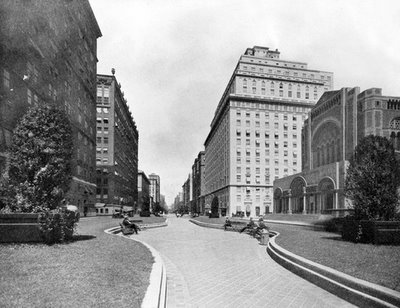 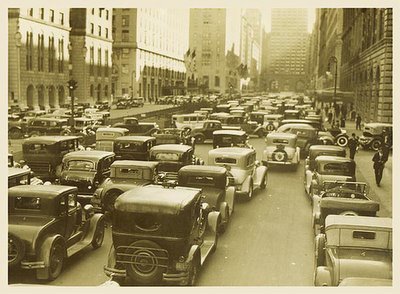 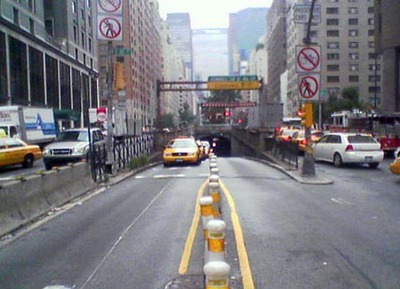 The second is subtler. Look at that last image: the "no-pedestrian-crossing" and "no-bicycles" warnings, the harsh yellow markings, the lights, the huge looming signs. They're not only hideous, they're distinctly inhuman. Walking down a street like that is like entering an alien civilization - nearly all of the visually prominent elements would not have any meaning in a pedestrian environment. Those signs and signals serve not human, but mechanical, purposes - they exist purely to enable the industrial function of moving big rolling chunks of steel around without too many fatal collisions. Modern streets do not merely ignore pedestrians, or fail to serve them. They don't merely place pedestrians at risk. Rather, they require pedestrians (often with the force of law) to act like cars. In a humane streetscape, pedestrians make beelines from point to point, when hurrying, and when at leisure, wander in loops and digressions. Pedestrians walk quicker or slower, or stop entirely, as their purposes dictate - not according to arbitrary mechanical timers. On today's streets, by contrast, pedestrians have to travel in straight, block-long segments, turn only at street corners, cross only at intersections, stop arbitrarily to wait for traffic lights, anticipate traffic flow, follow a fat lawbook worth of rules, and generally abandon all the advantages of walking; they turn themselves into very slow, very vulnerable, cars. Look at the visual environment: the ugliness of parking meters, parking signs, huge billboards, huge speed-friendly store signage, flashing lights, garish yellow lines, and all the other detritus of traffic control. That exacts a mental cost from everyone, but supplies a benefit only to drivers, or rather, to their cars (it's maddening for drivers, too). Pedestrians have to put up with this baffling visually-noisy environment, have to read the signs, obey the lights, beware the hazards, listen to the back-up alarms, and so on, just as drivers do. Instead of enjoying the simplicity of walking freely, they have to turn themselves, mentally, into drivers, not walkers. A motorist is half-blind, three-quarters deaf, and entirely cut off from scent, taste, touch and kinesthetic awareness - and on a typical city street, blinded by lights, deafened by traffic din, poisoned by exhaust fumes, paralyzed by narrow sidewalks and walk/don't walk signs, a so-called "pedestrian" is almost equally deprived of sensory competence. On such a street, no one is a pedestrian; everyone is a driver. When people deride the car-free vision, we tend to think they're making a foolish wasteful choice: to drive rather than to walk. They're not; today's streets offer them no such choice. Rather, people are forced to choose between driving a car, and driving without a car. They have had no experience of walking in city streets. They've only had the experience of driving without a car - subject to all the restrictions and disadvantages of urban driving, without any of the advantages of walking. I don't know how to fix this problem, but it's fundamental. We're trying to promote walking among people who have never experienced genuine urban walking, but think that they have. As long as they equate walking with driving-without-a-car, we're doomed.* Car-free days are an obvious start; so are car-free zones, so are speed limits set to a jogging speed, legal mid-block crossing, raised intersection crosswalks (as giant speed bumps and as crossings at sidewalk grade), and we can all think of others. But until we find ways to let pedestrians act like pedestrians, experience viscerally the liberating character of humane urban walking, they're never going to get out of their cars. Thoughts? *Ditto for bicycles, streetcars, trains, buses - all crippled by the need to accommodate cars.
Dominic Brown
Books & Films
From the publisher's blurb: Abandoned lots and litter-strewn sidewalks, or rows of green beans and pockets of wildflowers? Graffitti-marked walls and desolate bus stops, or shady refuges and comfortable seating? What transforms a dingy, inhospitable area into a dynamic gathering place? How do individuals take back their neighborhood? Neighborhoods decline when the people who live there lose their connection and no longer feel part of their community. Recapturing that sense of belonging and pride of place can be as simple as planting a civic garden or placing some benches in a park. The Great Neighborhood Book explains how any community can be improved and enlivened, not by vast infusions of cash, not by government, but by the people who live there. Through real-life stories, this book addresses such challenges as traffic control, crime, comfort and safety, and developing economic vitality. Offering compelling evidence of how people in communities have enhanced their own neighborhoods through "Placemaking" - the PPS term for the process of transforming public space - this exciting guide offers inspiring real-life examples that show the magic that happens when individuals take small steps, and motivate others to make change. It joins The Social Life of Small Urban Spaces and How To Turn a Place Around in the PPS library of publications that explore a place-based approach to improving neighborhoods.
Truth in advertising: I consider Michael a friend and spent two days as a guest of the Arths when they lived in Santa Barbara. This is the story of Michael's "invasion" of the Garden District of De Land, Florida, an inland town not far from Daytona. When Michael arrived, this area was crack central. Housing was extremely dilapidated and the "garden" part of the name was nowhere to be found. Michael bought a few houses and started fixing them up. The police advised him to buy a gun, so he did: nail and staple guns. He set about rebuilding the neighborhood one house at a time. Michael tried to work with everybody in a calm but determined way. The results can only be called phenomenal. Today this neighborhood thrives and is full of beauty. Neighborliness has replaced crime. The area cannot be called carfree (and a fair bit of footage is shot from vehicles), but this is an inspiration for anyone who ever sought to turn a place around. You might call Michael a practical dreamer. Michael promotes what he calls the "New Pedestrianism." This is as close as modern American practice gets to carfree. It turns the New Urbanism inside out - the main streets are for bikes and pedestrian, with cars relegated to back alleys. In auto-centric America, this is about as radical a proposal as is likely to be built today. Michael has some projects at the proposal stage. The film is too long, and Michael sometimes comes across as a bit full of himself, but this is a truly inspiring story and a great act of personal courage. Hats off to Michael. Anyone who can get this film into distribution channels should contact Michael. The film will be doing the festival circuit, which may get it some attention. Michael sent this panorama and further elaborated:  Phoenix Court, Garden District ©Michael E. Arth Here's a panorama of car free Phoenix Court in the Garden District. This used to be a treeless, dirt parking lot, with a dumpster at one end. The porches, the fences, the landscaping and the renovations were a part of my Garden District renovations. I made condos out of these homes and sold them to individuals, figuring that owners would take better care of it than renters. The buildings at the far left and far right used to be garage apartments behind the houses in the middle, which were originally oriented toward the street on the other side. Putting in the porches in what was the back gives the appearance that they face the courtyard instead of the street. Having an extravagant fountain and courtyard is very inexpensive when shared by five buildings (the fifth building is behind the camera).
Hot New LinksThe links below will open in a new browser window:
The History of New York City Public Space New Means to PROMote Pedestrian Traffic in Cities (Guidebook) by the European Commission [PDF!] New Means to PROMote Pedestrian Traffic in Cities (Part 2: Families of Solutions Overview) by the European Commission [PDF!]
About Carfree Times
Next IssueThe next issue of Carfree Times is expected in November 2007.
Subscribe to Carfree TimesCarfree Times is published quarterly at Carfree.com. To receive e-mail notices of new issues, please visit the subscription page or send e-mail with the word "Subscribe" in the subject line. We do not share our mailing list.
|
| Editor | J.H. Crawford |
| Send e-mail |
Back to Carfree.com
Carfree Times Home
Back to Carfree Times Issue 46
Forward to Carfree Times Issue 48
About the book: Carfree Cities
E-mail
carfree.com
Copyright ©2007 J.Crawford


